Geothermal Energy Factsheet
Geothermal Resource and Potential
- Geothermal energy is derived from the natural heat of the earth.1 It exists in both high enthalpy (volcanoes, geysers) and low enthalpy forms (heat stored in rocks in the Earth’s crust). Nearly all heating and cooling applications utilize low enthalpy heat.2
- Geothermal energy has two primary applications: heating/cooling and electricity generation.1
- Ground source heat pumps for heating and cooling use 75% less energy than traditional heating and cooling systems.4
- The U.S. has tapped less than 0.7% of geothermal electricity resources; the majority can become available with Enhanced Geothermal System technology.5,6
- In 2021, there were 3,692 MW of geothermal electricity plants in operation in the U.S.—the most of any country—and development has been growing at a rate of 3% per year.6
- Electricity generated from geothermal plants is projected to increase from 17 billion kWh in 2022 to 37.2 billion kWh in 2050.7,8 In 2021, California and Nevada were the states with the most installed geothermal energy capacity, with 95% of U.S capacity.6
- The U.S., Indonesia, Philippines, Turkey, New Zealand, and Mexico had 74% of global installed geothermal power capacity in 2022.9
U.S. Geothermal Resources3 at 10 km depth
Image
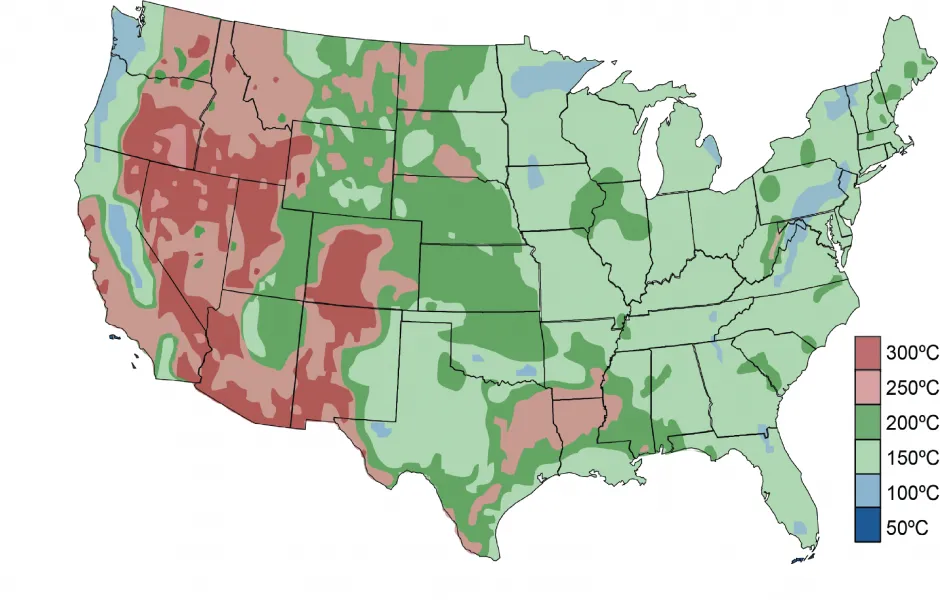
Geothermal Technology and Impacts
Direct Use and Heating/Cooling
- Geothermal (or ground source) heat pumps (GSHPs) are the primary method for direct use of geothermal energy. GSHPs use the shallow ground as an energy reservoir because it maintains a nearly constant temperature between 50-60°F (10–16°C).11
- GSHPs transfer heat from a building to the ground during the cooling season, and from the ground into a building during the heating season.11
- Direct-use applications include space and district heating, greenhouses, aquaculture, and commercial and industrial processes.12
Ground Source Heat Pump in a Residential Heating Application10
Image
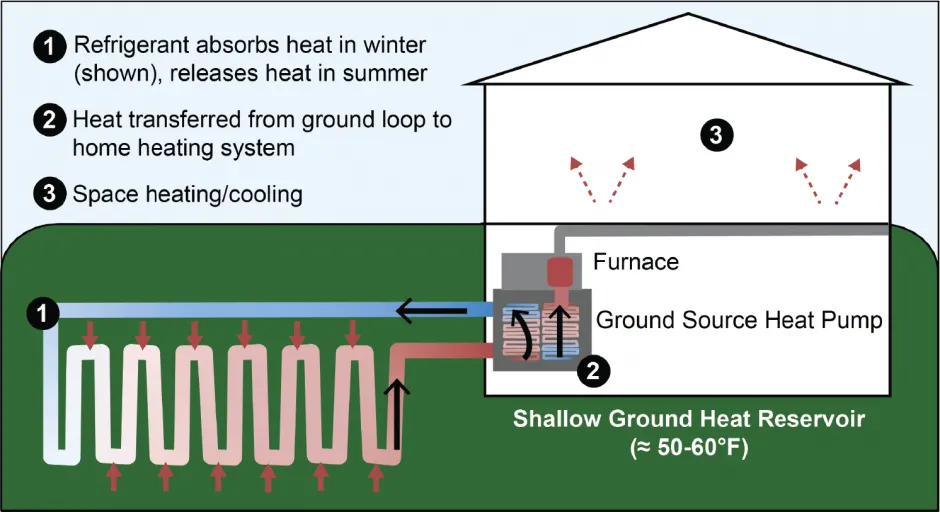
Electricity Generation
- Geothermal energy currently accounts for 0.4% of electricity generation in the United States.7
- In 2020, the U.S. generated the most geothermal electricity in the world: 18,831 GWh.9
- Hydrothermal energy, typically supplied by underground water reservoirs, is a main source of thermal energy used in electricity generation. The water is often pumped as steam to the earth’s surface to spin turbines that generate electricity.13
- Dry steam power plants use steam from a geothermal reservoir and route it directly through turbines, which drive generators to produce electricity.13
- Flash steam power plants pump hot water under high pressure into a surface tank at much lower pressure. This pressure change causes the water to rapidly “flash” into steam, which is then used to spin a turbine/generator to produce electricity. Flash steam plants are the most common type of geothermal power plants.13
- Binary cycle power plants feature geothermal water and a working fluid that are confined to separate circulating systems, or “closed loops.” A heat exchanger transfers heat from the water to the working fluid, causing it to “flash” to steam, which then powers the turbine/generator to produce electricity.13
- Enhanced Geothermal System (EGS) is a technology under development that could expand the use of geothermal resources to new geographic areas. EGS creates a subsurface fracture system to increase the permeability of rock and allow for the injection of a heat transfer fluid (typically water). Injected fluid is heated by the rock and returned to the surface to generate electricity.14
- According to the U.S. Department of Energy, there may be over 100 GW of geothermal electric capacity in the continental U.S., which would account for nearly 10% of current U.S. electricity capacity and be 40 times the current installed geothermal capacity.14
Flash Steam Geothermal Power Plant10
Image
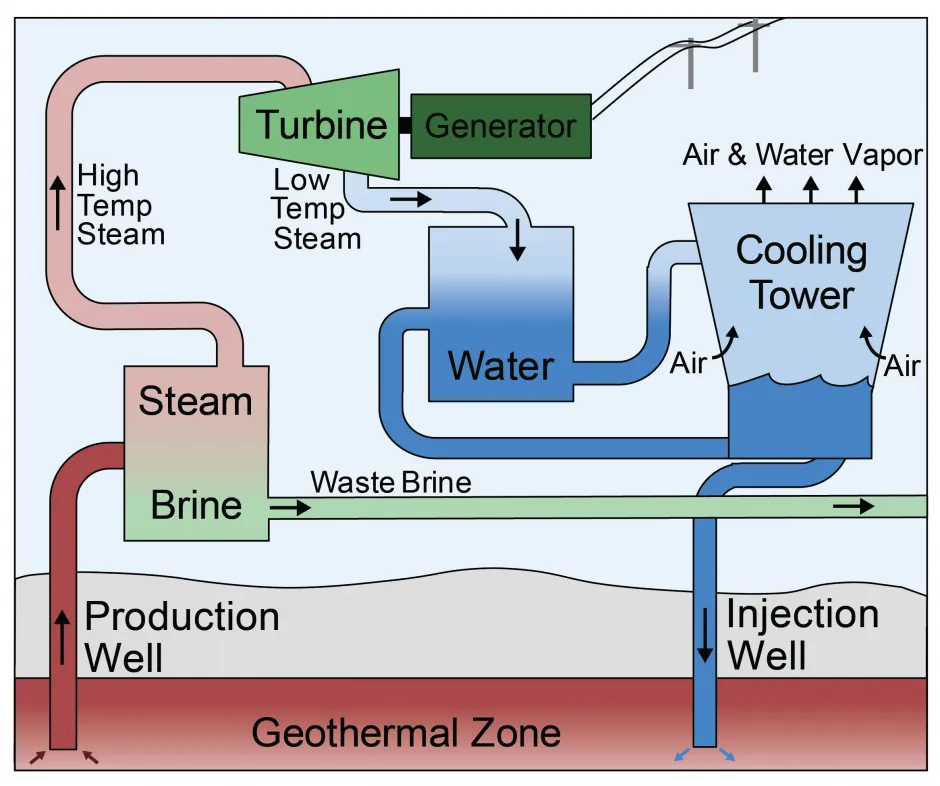
Installation, Manufacturing, and Cost
- The main stages of geothermal power development are resource exploration, drilling, reservoir/plant development, and power generation.16
- Capital costs for conventional geothermal power plants in the U.S. are approximately $2,500 per installed kilowatt of capacity.17
- Although the development of geothermal power requires a large capital investment, geothermal has low operating costs and a capacity factor of >90% (ratio of actual power production to production potential).16,18
- In 2016, geothermal electricity cost between 7.8-22.5¢ per kWh. As of May 2020, geothermal plants qualified for the federal Production Tax Credit (PTC).18
- In 2022, the Inflation Reduction Act renewed and expanded the PTC, which provides up to 2.6¢ per kWh for electricity generated from geothermal resources.19
Energy Performance and Environmental Impacts
- An average U.S. coal power plant emits roughly 35 times more carbon dioxide (CO₂) per kWh of electricity generated than a geothermal power plant.20
- Binary cycle power plants and flash power plants consume around 0.24-4.21 gallons and 1.59-2.84 gallons of water per kWh, respectively (compared to 15 gallons of water per kWh used by thermoelectric plants in 2015). 21,22
- Each year, U.S. geothermal electricity offsets the emission of 22 million metric tons (Mt) of CO2, 200 thousand metric tons (t) of nitrogen oxides, and 110 thousand t of particulate matter from coal-powered plants.18
- The U.S. DOE is actively funding research into combining carbon capture and storage with geothermal energy production, although the risks of long-term and high-volume geologic carbon sequestration are uncertain.23, 24
- Some geothermal facilities produce solid waste that must be disposed of in approved sites, though some by-products can be recovered and recycled.25
GHG Emissions from Power Generation32 by Life Cycle Stage
Image
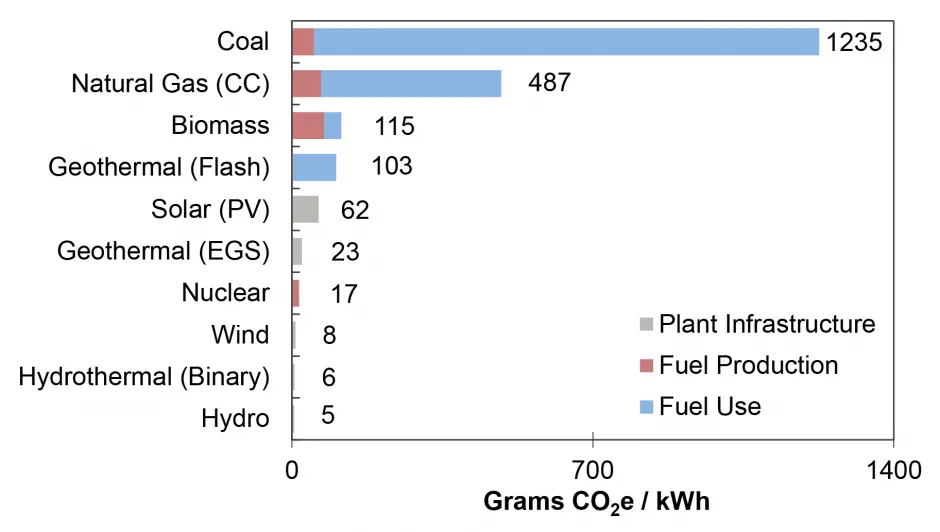
Solutions and Sustainable Actions
Funding Opportunities
- In 2019, there were 16 national laboratories and research institutions in the U.S. conducting research into geothermal energy technologies.26
- With a capacity factor of over 90%, geothermal electricity generation could offset coal, natural gas, or nuclear power as baseload supply in the electricity market.17
- Renewable Portfolio Standards (RPS) require electricity providers to obtain a minimum fraction of energy from renewable resources.27
- Renewable Energy Certificates (RECs) are sold by renewable energy producers in addition to the electricity they produce; for a few cents per kilowatt hour, consumers can purchase RECs to “offset” their usage and help renewable energy become more competitive.28
- A federal tax credit for homeowners can cover up to 30% of qualifying ground source heat pump system costs depending on construction date from 2006 through 2034.29
- Around 850 utilities in the U.S. offer consumers the option to purchase renewable energy, or “green power.”30
- Many companies purchase renewable energy as part of their environmental programs. Google, Microsoft, T-Mobile, Walmart, and The Proctor & Gamble Company were the top five users of renewable energy as of April 2023.31
Steamboat Hills Geothermal Power Plant33 Steamboat Springs, Nevada
Image
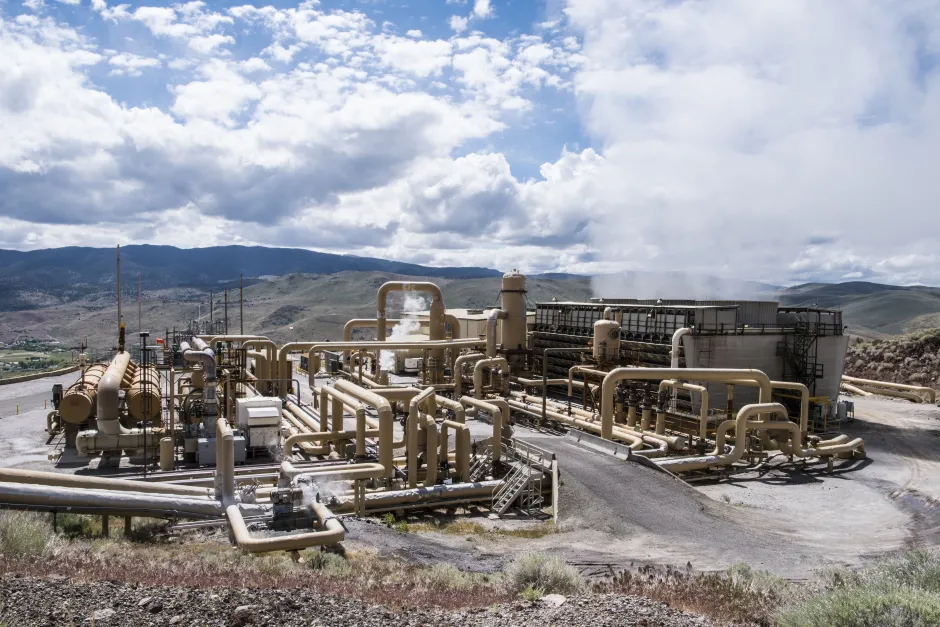
Cite As
Center for Sustainable Systems, University of Michigan. 2023. "Geothermal Energy Factsheet." Pub. No. CSS10-10.
References
- U.S. Department of Energy (DOE), National Renewable Energy Laboratory (NREL) (2021) “Geothermal Energy Basics.”
- Banks, D. (2008) An Introduction to Thermogeology: Ground Source Heating and Cooling.
- Massachusetts Institute of Technology (2006) The Future of Geothermal Energy: Impact of Enhanced Geothermal Systems (EGS) on the United States in the 21st Century.
- Geothermal Exchange Organization. (2019) Geothermal Benefits.
- U.S. Geological Survey (2008) Assessment of Moderate- and High-Temperature Geothermal Resources of the United States.
- U.S. Department of Energy, IEA Geothermal (2022) 2021 United States Country Report.
- U.S. Energy Information Administration (EIA) (2023) Monthly Energy Review June 2023.
- U.S. EIA (2023) Annual Energy Outlook 2023.
- International Renewable Energy Agency (2023) Dashboard - Capacity and Generation.
- Adapted from Geothermal Exchange Organization, Inc. (2010) Home Heating with GeoExchange.
- U.S. DOE, NREL (2019) “Geothermal Heat Pump Basics.”
- U.S. EPA (2019) Geothermal Heating and Cooling Technologies.
- U.S. DOE, EERE, Geothermal Technologies Office (GTO) (2023) “Electricity Generation.”
- U.S. DOE, EERE, GTO (2016) “How an Enhanced Geothermal System Works.”
- U.S. DOE, Idaho National Laboratory (2010) “What is Geothermal Energy?”
- U.S. DOE, NREL (2009) 2008 Geothermal Technologies Market Report.
- U.S. DOE, EERE, GTO (2021) “Geothermal FAQs.”
- U.S. DOE, Energy Efficiency and Renewable Energy (EERE) (2019) GeoVision: Harnessing the Heat Beneath Our Feet.
- U.S. EPA (2023) “Renewable Electricity Production Tax Credit Information.”
- U.S. DOE, EERE (2018) Geothermal Power Plants - Meeting Clean Air Standards.
- U.S. DOE, EERE (2015) Water Efficient Energy Production for Geothermal Resources.
- Dieter, C., et al. (2018) “Estimated use of water in the United States in 2015.” U.S. Geological Survey Circular 1441.
- U.S. DOE (2016) “DOE Investing $11.5 Million to Advance Geologic Carbon Storage and Geothermal Exploration.”
- Hitzman, M., et al. (2012) Induced Seismicity Potential in Energy Technologies. National Academies Press.
- U.S. DOE, EERE (2020) Geothermal Power Plants — Minimizing Solid Waste and Recovering Minerals.
- U.S. DOE, EERE, “Geothermal Research and Development Programs.”
- U.S. EPA (2021) “State Renewable Energy Resources.”
- U.S. DOE, NREL (2015) “Renewable Electricity: How do you know you are using it?”
- DSIRE (2022) “Federal Tax Credits for Residential Renewable Energy.”
- U.S. EPA (2018) “Utility Green Power Products.”
- U.S. EPA (2023) “Green Power Partnership: National Top 100.”
- U.S. DOE, Argonne National Laboratory (2010) Life Cycle Analysis Results of Geothermal Systems in Comparison to Other Power Systems.
- Photo courtesy of National Renewable Energy Laboratory.

